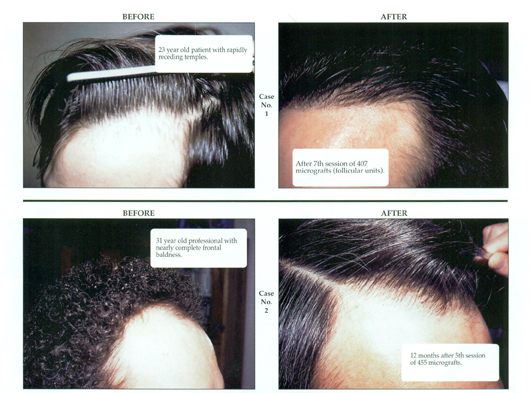Case Studies
Case Studies- Anterior Thinning of Scalp Hair
Click here to view the original newsletter in pdf format.
We have all seen unfortunate patients with older “bristle brush” hairlines from larger plugs. However, you may also have heard about the newer “follicular unit grafting” techniques utilizing micrografts produced under a stereotactic dissecting microscope. Since commencing this procedure several years ago, our level of patient satisfaction is the highest that it has been in the 26 years that I have performed hair replacement surgery.
With microscopic dissection, our surgical staff is able to precisely create micrografts with 1, 2, 3, or 4 hairs. We then create a “density gradient” with single hairs only for the hairline, a zone of 2-hair micrografts in the front of the scalp and 3-4 hair micrografts for the crown. As a result, extremely natural outcomes are now possible.
These follicular units can be placed into the frontal forelock and into lateral and posterior zones of thinning to counteract future hair loss and to prevent the future appearance of baldness. Very fine cloned hairs can be placed at the hairline for a feathered look.
I would like to share with you the following case studies illustrating how natural hair replacement can look in patients with ANTERIOR THINNING. You can view many more photographs at www. coloderm.com.

James M. Swinehart, M.D., President
Colorado Dermatology Center
Case Studies – Creation of Fine, Natural Hairlines
Click here to view the original newsletter in pdf format.
Next in our series of case studies shall be clinical examples of the creation of fine, natural HAIRLINES. A zone of single hairs, consisting of 100-200 follicles, is implanted at the desired location. This is closely followed by a zone of 100-180 2-hair micrografts immediately behind the single hairs. The anterior hairline zone is then covered with 3-hair micrografts. Follicular units (intact donor groupings) of 1, 2, or 3 hairs are dissected under magnification and are implanted using magnifiers into needle slits with ultrafine jeweler’s forceps.
If you viewed only the “after” photos in these three cases, could you tell that they had received transplants? If not, then you can appreciate the attention to detail necessary in creation of beautiful hairlines in hair restoration surgery: 300 or more micrografts have been placed into a frontal zone only 1 cm wide!
You may schedule a free hair transplant consultation by calling (303)744-1202.

James M. Swinehart, M.D., President
Colorado Dermatology Center
Case Studies – Diffuse Thinning of Scalp Hair
Click here to view the original newsletter in pdf format.
Patients with DIFFUSE THINNING of the scalp hair, due to male pattern baldness or female pattern alopecia, may have already tried Rogaine®. Men may see some benefit on the posterior scalp with Propecia® – but must take this for the rest of their lives in order to maintain the growth.
Now, with extensive micrografting utilizing microscopic follicular units containing 1-4 hairs each, we can prevent the visual appearance of baldness. The existing hairs are left undisturbed –but the tiny bundles of follicular bulbs are meticulously inserted under magnification into tiny needle holes in between the patient’s remaining scalp hairs. We can also recreate the “whorl” on the posterior crown, and graft into areas of anticipated future thinning at the edges of the balding scalp.
Micrografting is both an art and a science. Recently, the insertion of 1,720 micrografts took us 7 hours for the physician and four surgical assistants. We have performed over 1,500 grafts in a single session in a female with familial thinning, and over 1,800 micrografts in several men. However, the fruits of this labor are well worth the effort.
Enclosed please find case studies of my patients with diffuse thinning of the scalp hair. Patients may view more photos as www.coloderm.com.

James M. Swinehart, M.D., President
Colorado Dermatology Center




